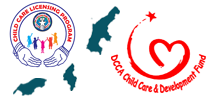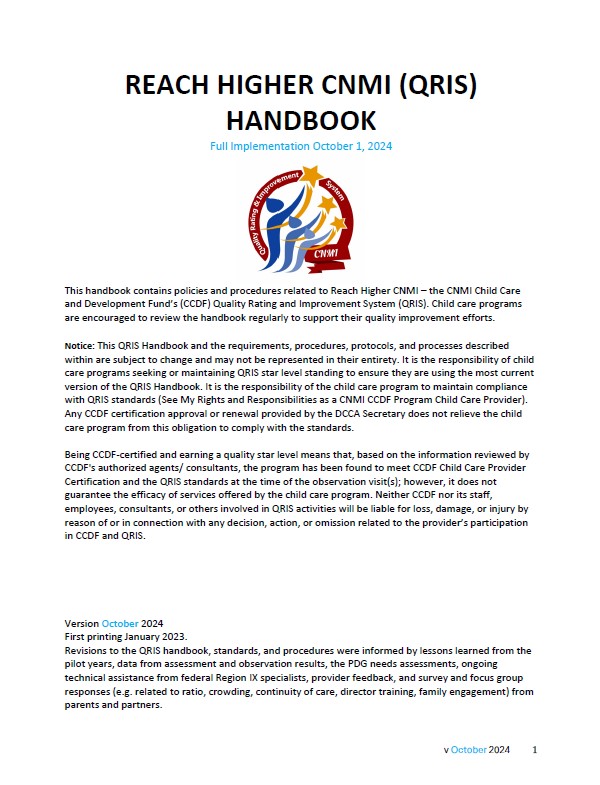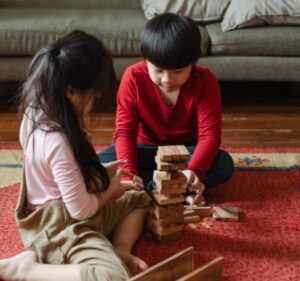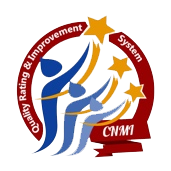SAIPAN Office Tel. (670) 664-2576/2575/2591/2593 • TINIAN Tel. (670) 989-2233 • ROTA Tel. (670) 588-7682 • Email: info.ccdf@chilcare.gov.mp
Quality Rating and Improvement System (QRIS)
The Quality Rating and Improvement System or QRIS is a way to “assess, improve, and communicate the level of quality in early care and education settings. The CNMI’s QRIS called Reach Higher, CNMI officially launched a Pilot Program on July 18, 2016 with the orientation for pilot provider sites. Seven license-based centers were randomly selected to represent small, medium, and large sized operations. At the beginning of the process, CCDF decided ECERS-R scores obtained in 2015 would be used as the baseline scores for pilot sites. Thus, only ITERS-R scores were obtained for the initial visits in 2016. One infant or infant/ toddler room and one toddler room was observed at each pilot site.
Star Level 1, represents the most basic quality level. Meeting these standard indicators is a mere statement that a program meets the most minimal qualifications for running a child care business in the CNMI. In the first verification visits of 2016, five of the seven sites had issues with expired police clearances, floor plans, health certificates, and/ or missing documents that were required by CCDF and/ or the CNMI Licensing Program. A year after implementation, issues had been resolved and all seven pilot sites earned Star Level 1 quality standing.
At Star Level 2, an increase in the number of centers meeting standard indicators was noted. All sites completed their ERS self-assessments, posted developmentally appropriate schedules, made community resources available to parents, and communicated with parents in various ways. Five centers completely updated their parent handbook to meet all CCDF requirements. Three centers were unable to implement all safe sleep practices. Of the three, one would have earned Star Level 3 if it had met this indicator. Another three centers lost all star level standing beyond Star Level 1 due to licensing citations.
At Star Level 3, little change was noted in centers meeting health and safety indicators. Notable increases were observed in the number of centers completing ASQs, incorporating the Early Learning Guidelines in lesson planning, following IEPs for children with disabilities, and addressing their Quality Improvement Plans (QIPs).
At least six of the 11 indicators at Star Level 4 were attainable for more than half of the centers: four had no citations, six maintained age-appropriate staff-child ratio, five met QIP-targeted coaching hours, four received scores above one on the activities subscale of the ERS, all incorporated ELGs into lesson plans, and five provided opportunities for feedback from parents and staff in the form of formal surveys.
By the 2017 follow-up observations, only two centers are at minimum quality, as measured by the environment rating scales. All other centers surpassed the minimum required rating of 3.00 in Star Level indicators. In fact, these higher rated centers received total scores of 4.00 and higher.
Also notable are the 2015 ECERS-R score for preschool programs. Only two centers received scores in the 2.00 range during the first observations in 2015. Even then, most pilot centers were already attaining ratings above 3.00.
Overarching goals for improvement include:
• Meeting basic health and safety requirements (e.g. safe sleep practices, napping, diapering, meals/ snacks, indoor space) and monitoring children’s development.
• Engaging children in meaning interactions that include thick conversations and the development of higher-order thinking skills.
• Supporting children with disabilities and their families – including training staff in inclusive practices.
• Providing assistance to parents and families that help connect home and school/ center learning.
In the second year of the pilot, which began on December 2017, three more sites were added. Some changes to the Pilot 1 were included. A big difference is the star levels. From Pilot 1’s 4 Star Levels, for Pilot 2, there will now be 5 Star Levels. Some programs standards were also modified, changed, or deleted. Pilot 2 activities. Included the SACERS-U baseline observations. Data from the SACERS-U revealed inadequate quality in the following areas: adequate space and furnishings; health and safety requirements for meals/ snacks and personal hygiene; implementing activities for music/ movement, blocks/ construction, dramatic play/ theater, math/ reasoning activities, and science/ nature activities; and meeting the needs of children with disabilities. These areas also emerge as targets for overarching quality improvement goal.





